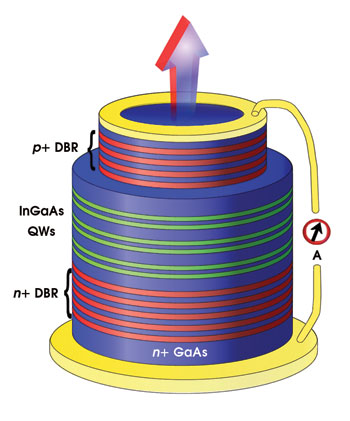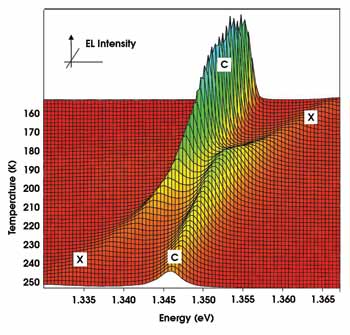Quasiparticles used to produce LEDs based on standard GaAs technology operate at near-room temperature and may find use in ultraefficient lighting applications, quantum computing and more.
Dr. Pavlos Savvidis, University of Crete
A new generation of light emitters based on hybrid half-light, half-matter quasiparticles called polaritons promises quantum efficiency and ultralow power consumption. The key feature supporting dramatic improvement in device performance is the important ability of polaritons to accumulate in a single macroscopically coherent polariton state, owing to their very light effective mass and reduced density of states. Laser emission is achieved when polaritons decay from such a macroscopically occupied coherent state, the advantage being that these emitters require a threshold carrier density two orders of magnitude lower than that required for a normal photon laser.
A polariton is a quantum mechanical amalgam of an electron-hole pair (exciton) and a photon that is emitted when the electron drops back into the hole. When high-reflectivity mirrors are placed on either side to form a microcavity and to trap the emitted photons, the recycled photon is reabsorbed to create another exciton, and the cycle repeats. With this continuous exchange of energy between a photon and an exciton, you get a new quasiparticle, which spends half its time as light and the other half as matter.

Figure 1. A schematic of the microcavity polariton LED device shows the structure. Dry etching was used to expose the p-distributed Bragg reflectors, forming the round mesa. A ring-shaped p-type ohmic contact was deposited on top of the mesa, and the n-type contact was deposited on the back of the substrate. DBR = distributed Bragg reflector. Reprinted from Nature with permission of the researchers.
Polariton LEDs
Up to now, polariton emission and lasing have been achieved only under optical excitation. A number of key issues, associated with the fabrication of high-quality doped mirrors and with the stability of polaritons under electrical injection, have so far thwarted the realization of any electrically pumped polariton-emitting semiconductor device. In work published in the May 2008 issue of Nature, our team reports the first step toward fulfilling the promise of an electrically driven polariton device that was made using the well-developed GaAs technology. What’s more, the electrically pumped GaAs polariton LED device operates at near-room temperature and highlights the potential of such devices for real-world polariton-based optoelectronic applications.

Figure 2. Electrically driven polariton emission shows the characteristic polariton dispersion. EL = electroluminescence intensity; X = exciton resonance; C = cavity mode.
The microcavity LED structure was grown using molecular beam epitaxy, and it sandwiches three pairs of InGaAs quantum wells between two GaAs/AlAs distributed Bragg reflectors. The ohmic contact to the n-type material is a gold-germanium alloy, and to the p-type, a titanium-platinum ring contact is made. The microcavity is five half-wavelengths long. The sample was designed to exhibit the strong coupling regime between excitons and photons at elevated temperatures to avoid injection problems associated with the high resistivity of p-type distributed Bragg reflectors at low temperatures.
The electrically pumped polariton-emitting devices operating in the strong coupling regime present several advantages. First, they can offer dramatic enhancement of the spontaneous emission rate, even when compared with conventional resonant cavity LEDs. In the strong coupling regime, the characteristic time in light–matter interactions is at least two orders of magnitude lower than the radiative lifetime. This makes polariton-based emitters ideal candidates to become future LED devices with unprecedented quantum efficiency and ultralow power consumption. Second, although the current injection scheme does not yield polariton laser operation, we expect that devising a more sophisticated scheme that efficiently places polaritons in the macroscopically coherent state will lead to the demonstration of polariton lasing under electrical injection. Once that is achieved, current thresholds two orders of mag- nitude lower would be exhibited. In general, polariton devices will have the important advantages of very low power consumption and ultrafast operation.
Our group’s immediate goal is to demonstrate a room-temperature polariton-emitting device. There is no fundamental reason for these devices not to operate at room temperature. In fact, one of the main conclusions of our work is that, by dressing excitons with photons, one can substantially suppress the exciton-phonon scattering, making GaAs-based polaritonic devices feasible at room temperature.
Meet the author
Pavlos Savvidis is an assistant professor at the University of Crete in Greece; e-mail: [email protected].